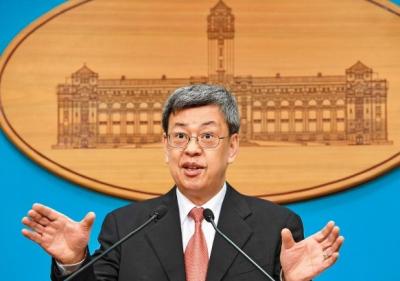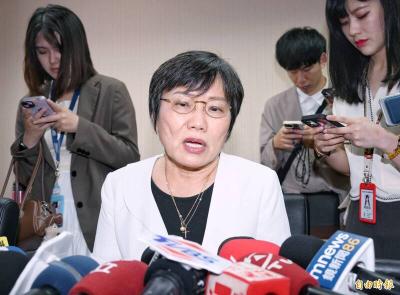By supporting the “one China” framework, President Ma Ying-jeou (馬英九) has stripped Taiwanese of their options to decide the nation’s future, violating his campaign pledge that the nation’s 23 million people would have the power to do so, according to the majority of respondents in a public opinion poll released yesterday.
The survey, conducted by Taiwan Thinktank, showed that most respondents were displeased with Ma’s recent handling of cross-strait affairs and major domestic policies, including the proposed 12-year education program and the planned national referendum to decide the fate of the Fourth Nuclear Power Plant in Gongliao District (貢寮), New Taipei City (新北市).
The discontent contributed to Ma’s low 17.4 percent approval rating, the lowest mark since the think tank began conducting its polls in March last year, while his disapproval rating of 73.3 percent also hit a record high, Hsu Yung-ming (徐永明), convener of the think tank’s poll panel, told a news conference.

Photo: CNA
Comments made by former Chinese Nationalist Party (KMT) chairman Wu Poh-hsiung (吳伯雄) in his recent meeting with Chinese President Xi Jinping (習近平) — which highlighted the “one China” framework and the shared ancestry of the countries’ peoples — seems to have caused a backlash among Taiwanese, with 61.6 percent of those polled saying the KMT’s ideology had stripped the people of their options for the future and 71.5 percent of those polled saying it violated Ma’s campaign promise.
“The KMT’s statement basically told Taiwanese that they would have only one option in the future: unification,” said Tung Li-wen (董立文), an associate professor of the Graduate School of Public Security at Central Police University and a Taiwan Thinktank consultant.
Most of the survey’s participants said they are not impressed with how the Ma administration conducted the negotiations with Beijing for the service trade agreement signed on Friday in Shanghai, nor with the proposed establishment of representative offices for the Straits Exchange Foundation in China and for the Association for Relations Across the Taiwan Straits in Taiwan.
Since almost all the key details about the service pact were not disclosed, discussed or reviewed before it was signed, more than half — 58.8 percent — of the respondents said the process was inappropriate and 80.4 percent supported the Legislative Yuan reviewing the pact.
With regards to the representative offices, 77.6 percent of those polled said the issue was not urgent, while 69.7 percent of the respondents said that if they are established, they should be authorized with the same functions as foreign consulates.
The survey found that 79.9 percent of the respondents viewed Taiwan and China as different countries, with only 12.1 percent supporting a “one China” structure and 8 percent declining to answer.
On the issue of independence and unification, 8.8 percent of the poll participants said they were pro-unification in general, with 1.2 percent of them saying they favored immediate unification and 7.6 percent preferring maintaining the “status quo” for the time being and unifying in the future.
By contrast, 20.6 percent supported Taiwan independence, including 6.4 percent who called for immediate independence and 14.2 percent who preferred a more gradual independence process.
Almost two in three people advocated maintaining the “status quo,” with 31.9 percent of those polled favoring temporarily maintaining the present cross-strait situation and 34.7 percent calling for the “status quo” to be made permanent, the poll found.
“The results appear to suggest that both Ma’s cross-strait policy and Beijing’s Taiwan policy have been failures because the people of Taiwan are not buying what the president and China are selling,” Democratic Progressive Party Legislator Lin Chia-lung (林佳龍) said.

Taiwan would welcome the return of Honduras as a diplomatic ally if its next president decides to make such a move, Minister of Foreign Affairs Lin Chia-lung (林佳龍) said yesterday. “Of course, we would welcome Honduras if they want to restore diplomatic ties with Taiwan after their elections,” Lin said at a meeting of the legislature’s Foreign Affairs and National Defense Committee, when asked to comment on statements made by two of the three Honduran presidential candidates during the presidential campaign in the Central American country. Taiwan is paying close attention to the region as a whole in the wake of a

President William Lai (賴清德) has appointed former vice president Chen Chien-jen (陳建仁) to attend the late Pope Francis’ funeral at the Vatican City on Saturday on his behalf, the Ministry of Foreign Affairs said today. The Holy See announced Francis’ funeral would take place on Saturday at 10am in St Peter’s Square. The ministry expressed condolences over Francis’ passing and said that Chen would represent Taiwan at the funeral and offer condolences in person. Taiwan and the Vatican have a long-standing and close diplomatic relationship, the ministry said. Both sides agreed to have Chen represent Taiwan at the funeral, given his Catholic identity and

Chinese Nationalist Party (KMT) Chairman Eric Chu (朱立倫), spokeswoman Yang Chih-yu (楊智伃) and Legislator Hsieh Lung-chieh (謝龍介) would be summoned by police for questioning for leading an illegal assembly on Thursday evening last week, Minister of the Interior Liu Shyh-fang (劉世芳) said today. The three KMT officials led an assembly outside the Taipei City Prosecutors’ Office, a restricted area where public assembly is not allowed, protesting the questioning of several KMT staff and searches of KMT headquarters and offices in a recall petition forgery case. Chu, Yang and Hsieh are all suspected of contravening the Assembly and Parade Act (集會遊行法) by holding

Lawmakers from the Democratic Progressive Party (DPP) yesterday established a friendship group with their counterparts in Ukraine to promote parliamentary exchanges between the two countries. A ceremony in Taipei for the Taiwan-Ukraine Parliamentary Friendship Association, initiated by DPP Legislator Chen Kuan-ting (陳冠廷), was attended by lawmakers and officials, including Deputy Minister of Foreign Affairs Francois Wu (吳志中) and European Economic and Trade Office in Taiwan Director Lutz Gullner. The increasingly dire situation in Ukraine is a global concern, and Taiwan cannot turn its back when the latter is in need of help, as the two countries share many common values and interests,